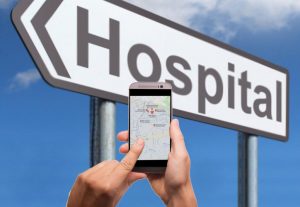
Transportation barriers prevent millions of people from accessing health care every year. Recent estimates suggest that 3.6 million Americans miss or delay nonemergency medical treatment annually, despite having health care coverage, due to lack of transportation to care facilities.
New research by Mary Wolfe, doctoral candidate, and Noreen McDonald, professor and chair of the Department of City and Regional Planning at The University of North Carolina at Chapel Hill, asks, “How is ride-hailing technology changing health care transportation in the United States?” Ride-hailing is booking rides and paying for car service through a smartphone app with a transportation network company (TNC) such as Uber or Lyft.
“It is widely acknowledged that when patients have access to routine and preventative care, overall health outcomes improve and costly ambulance bills or emergency department visits can be avoided,” says Wolfe. As the health care market moves towards value-based arrangements, treatment adherence is critical. At the same time, the U.S. has seen a proliferation and normalization of shared mobility technology in recent years. It is estimated that 24 percent to 43 percent of the U.S. population uses some form of ride-hailing service.
Ride-hailing companies like Uber and Lyft have entered the market to capture a significant share of current spending on nonemergency health care transportation. “Across the country, care providers are partnering with shared mobility services to establish new ways for patients to access on-demand rides to and from medical appointments” noted McDonald. “So, we did a nationwide scan to examine the current landscape of these innovative health care mobility services who are leveraging ride-hailing technology to improve service delivery of health care transportation.”

Wolfe and McDonald identified three core types of innovation or collaboration. The first is when a health care provider leverages ride-hailing technology to book patient trips. “This was the most common type of innovation we found, and it primarily involves transportation companies tailoring the ride-hailing experience to the health care industry,” says Wolfe. “The critical feature of this innovation is the added HIPPA-compliance of the booking process.” (HIPPA stands for Health Insurance Portability and Accountability Act, a U.S. law designed to provide privacy standards to protect patients’ medical records.) Health care associates can order rides from ride-hailing services through a HIPPA-compliant web platform; these centralized dashboards also allow providers to track patients’ trips, record billing and spending information and send patient reminders to a mobile or landline phone. Importantly, providers can schedule rides on behalf of patients even if they don’t have a smartphone. An example of this innovation is Uber Health, which launched in March 2018.
The second type of innovation Wolfe and McDonald identified is when an insurer partners with a ride-hailing company. This is when a health plan or care delivery system formally partners with existing ride-hailing service(s) to expand transportation services offered to beneficiaries or offers these services for the first time. “While examples of this type were limited,” notes McDonald, “it is likely that these types of partnerships will become more common as insurers increasingly offer more supplemental, non-medical benefits as a result of a larger shift of the health care industry to value-based care.” This collaborative innovation reflects insurers’ acknowledgement of transportation to care as a social determinant of health. For example, Blue Cross Blue Shield partnered with Lyft in May 2017 to add the ride-hailing service for medical appointments to some company plans.
The third type of innovation is when a paratransit provider partners with a ride-hailing company. Due to the demand-responsive nature of paratransit provisions (e.g. services do not operate over a fixed schedule like a standard public bus; rather, vehicles are dispatched on request and operate door-to-door), paratransit services have been said to be a sort of progenitor of mobile app-based TNCs. Sources that were located reference the increased flexibility and reliability of ride-hailing services compared to traditional paratransit. In most cases, Wolfe and McDonald found transit agencies are subsidizing these trips while in a pilot phase, so the long-term viability of these partnerships is unknown. A prominent example of this type of collaboration is led by the Massachusetts Bay Transportation Authority’s Paratransit service called the “RIDE.” Since September 2016, the RIDE has been piloting a program with Lyft and Uber and the pilot has been extended several times.
The study concludes that the on-demand nature of rides and integration of ride requests and payment options appear to be the strongest drivers of these innovations. “While new partnerships and companies continue to emerge in health care mobility services, it is important for both health care providers and transportation providers to evaluate programs to ensure that they are accessible to the most vulnerable patient populations,” explains Wolfe. While many of the partnerships and companies encountered are implementing avenues of utilization outside of traditional smartphone apps (e.g. dial-on options from a landline), patient level of comfort with and perception of ride-hailing is likely a very important determinant of uptake. Depending on patients’ level of previous experience with ride-hailing services, any TNC-based offering may be unfamiliar territory to the patient population it aims to serve.
Editor’s Note: Wolfe presented these findings at the Association of Collegiate Schools of Planning Annual Conference in October 2018 and will present at the Transportation Research Board meeting in January 2019. This research was funded in part by a CURS-supported Dwight David Eisenhower Transportation Fellowship Award received by Mary Wolfe. Noreen McDonald is director of the Carolina Transportation Program and a CURS Faculty Fellow.
This article originally appeared at CURS.UNC.EDU